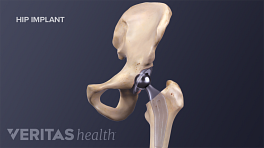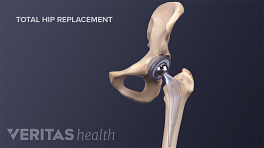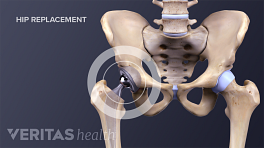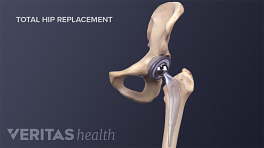In addition to medical preparations, a patient scheduled for joint replacement surgery may be asked to engage in pre-surgical weight loss, hip strengthening exercises, and making changes at home. These types of preparations are detailed below.
See Indications and Eligibility for Total Hip Replacement Surgery
In This Article:
- Preparing for Total Hip Replacement Surgery
- Other Preparations for Total Hip Replacement Surgery
Pre-surgical weight loss and hip strengthening exercises
There is no set weight limit for having hip replacement surgery. However, some doctors will suggest that overweight patients try to lose weight before surgery. Lowering weight can reduce the chances of post-surgical infection.
Many doctors also suggest hip-strengthening exercises before surgery. Strengthening the muscles around the hip can hasten recovery. Hip-strengthening exercises that can be done lying down are listed below.
Gluteal squeezes. Lying down on the back, the patient squeezes the gluteal muscles for 10 seconds.
Quad squeezes. Lying down on the back, the patient squeezes the muscles of the upper thigh.
Hip abduction. Lying down on the back, the patient gently moves one leg as far to the side as possible then returns the leg to center—a bit like making a snow angel.
Heel slide. Lying down on the back, the patient bends one knee and gently slides the heel toward the buttock. The patient holds the pose for several seconds, and then slides the heel back to the starting point.
Doctors and physical therapists can guide patients in deciding what exercises to do and how many repetitions are appropriate.
Suggested lifestyle and home preparations
By making some simple changes around the house, a patient can avoid deep bending and minimize the possibility of hip injury during the recovery period. Other preparations can maximize rest and comfort.
See Total Hip Replacement Surgery Recovery
Before buying additional equipment, such as raised toilet seats and walkers, patients may want to talk to their doctors and insurance providers. Many physicians and hospitals arrange for accommodative equipment to be provided at the time of discharge from the hospital.
See Postoperative Care for Hip Replacement
The list below is not exhaustive, and patients may identify other ways to tailor their homes to accommodate specific needs.
- If possible, arrange to spend sleeping and waking hours on the same floor in order to avoid stairs.
- If possible, adjust the bed height (not too high or too low) to help ease getting in and out of bed.
- Arrange for transportation, as most patients cannot drive for several weeks after surgery.
- Obtain a handicap parking placard for the car. This requires a doctor’s approval, though the specific regulations and paperwork vary from state to state. Patients may be eligible to use a placard before surgery as well as after.
- Have loose, comfortable underwear and pants to wear post-surgery, because tight clothing can irritate the surgical wounds.
- Get a reaching tool—a long pole with a claw or pincher on the end—to avoid having to bend down and pick things up.
- Arrange cabinets and closets so that commonly used items are not stored on lower shelves.
- Stock up on pre-made meals, canned food, and toiletry items to avoid having to run errands post-surgery.
- Arrange for a spouse, friend, or other caregiver to provide meals and help around the house.
- Leave essential items like the TV remote control, phone, wastebasket, and tissues where they can be easily accessed.
- Take away or move anything that might be tripped over, such as area rugs or electrical cords.
- Make sure all stairs have sturdy railings.
- Install small rails or grab bars near toilets and in showers.
- Install a modified toilet seat. A higher seat will minimize deep bending, making it easier to sit down and get up.
- Have cold packs available to help alleviate swelling and heating pads to warm up the hip joint.
- Consider practicing using walkers, canes, and other assistive devices ahead of time to ensure proficiency using them.
- Make sure to get regularly scheduled or necessary appointments (such as hair and dental appointments) out of the way before surgery.
While these adjustments may sound simple, they can go a long way to easing the recovery period and avoiding potential injury.











